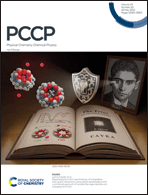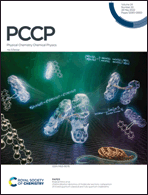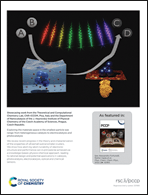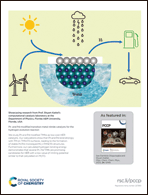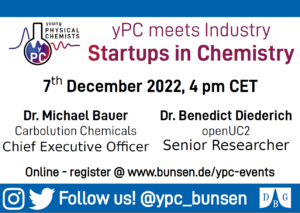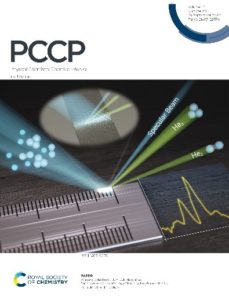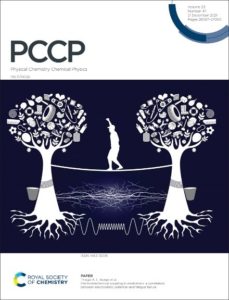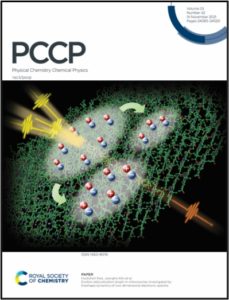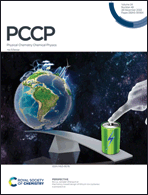 |
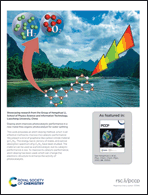 |
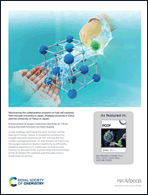 |
|
| Mechanics-based design of lithium-ion batteries: a perspective
Bo Lu, Yanan Yuan, Yinhua Bao, Yanfei Zhao, Yicheng Song and Junqian Zhang Phys. Chem. Chem. Phys., 2022, 24, 29279 DOI:10.1039/D2CP03301A |
Doping atom improves photocatalytic performance in a new metal-free organic photocatalyst for water splitting
Hengshuai Li, Xiaocheng Hu, Dong Fan, Zhihao Wang, Haiquan Hu, Feng Guo, Zhenbao Feng, Jun Li, Maoye Yin and Zhi Li Phys. Chem. Chem. Phys., 2022, 24, 29350 DOI:10.1039/D2CP02779H |
Enhancement of oxygen reduction reactivity on TiN by tuning the work function via metal doping
Mitsuharu Chisaka, Toshiyuki Abe, Rong Xiang, Shigeo Maruyama and Hirofumi Daiguji Phys. Chem. Chem. Phys., 2022, 24, 29328 DOI:10.1039/D2CP04326B |
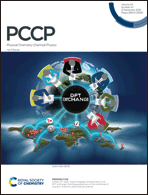 |
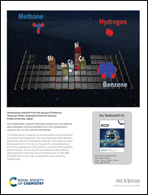 |
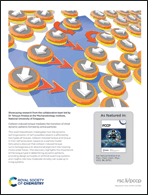 |
|
| DFT exchange: sharing perspectives on the workhorse of quantum chemistry and materials science
Andrew M. Teale, Trygve Helgaker, Andreas Savin, Carlo Adamo, Bálint Aradi, Alexei V. Arbuznikov, Paul W. Ayers, Evert Jan Baerends, Vincenzo Barone, Patrizia Calaminici, Eric Cancès, Emily A. Carter, Pratim Kumar Chattaraj, Henry Chermette, Ilaria Ciofini, T. Daniel Crawford, Frank De Proft, John F. Dobson, Claudia Draxl, Thomas Frauenheim, Emmanuel Fromager, Patricio Fuentealba, Laura Gagliardi, Giulia Galli, Jiali Gao, Paul Geerlings, Nikitas Gidopoulos, Peter M. W. Gill, Paola Gori-Giorgi, Andreas Görling, Tim Gould, Stefan Grimme, Oleg Gritsenko, Hans Jørgen Aagaard Jensen, Erin R. Johnson, Robert O. Jones, Martin Kaupp, Andreas M. Köster, Leeor Kronik, Anna I. Krylov, Simen Kvaal, Andre Laestadius, Mel Levy, Mathieu Lewin, Shubin Liu, Pierre-François Loos, Neepa T. Maitra, Frank Neese, John P. Perdew, Katarzyna Pernal, Pascal Pernot, Piotr Piecuch, Elisa Rebolini, Lucia Reining, Pina Romaniello, Adrienn Ruzsinszky, Dennis R. Salahub, Matthias Scheffler, Peter Schwerdtfeger, Viktor N. Staroverov, Jianwei Sun, Erik Tellgren, David J. Tozer, Samuel B. Trickey, Carsten A. Ullrich, Alberto Vela, Giovanni Vignale, Tomasz A. Wesolowski, Xin Xu and Weitao Yang Phys. Chem. Chem. Phys., 2022, 24, 28700 DOI:10.1039/D2CP02827A |
Size-dependent catalytic hydrogen production via methane decomposition and aromatization at a low-temperature using Co, Ni, Cu, Mo, and Ru nanometals
Yuta Fujimoto and Tomonori Ohba Phys. Chem. Chem. Phys., 2022, 24, 28794 DOI:10.1039/D2CP03713K |
Collision-induced torque mediates the transition of chiral dynamic patterns formed by active particles
Tetsuya Hiraiwa, Ryo Akiyama, Daisuke Inoue, Arif Md. Rashedul Kabir and Akira Kakugo Phys. Chem. Chem. Phys., 2022, 24, 28782 DOI:10.1039/D2CP03879J |
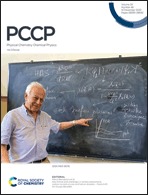 |
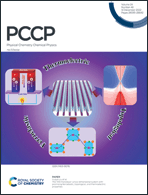 |
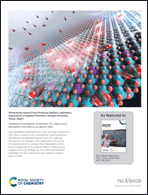 |
|
| New trends and challenges in surface phenomena, carbon nanostructures and helium droplets – Festschrift for Giorgio Benedek
Marco Bernasconi, Ricardo Díez Muiño, Pedro Miguel Echenique, Joseph R. Manson, Salvador Miret-Artés and J. Peter Toennies Phys. Chem. Chem. Phys., 2022, 24, 28103 DOI:10.1039/D2CP90196J |
The TiNI monolayer: a two-dimensional system with promising ferroelastic, topological, and thermoelectric properties
Wen Lei, Rui Hu, Shihao Han, Hongmei Yuan, Wenyan Jiao and Huijun Liu Phys. Chem. Chem. Phys., 2022, 24, 28134 DOI:10.1039/D2CP03105A |
Theoretical investigation of selective CO2 capture and desorption controlled by an electric field
Koki Saegusa, Kenshin Chishima, Hiroshi Sampei, Kazuharu Ito, Kota Murakami, Jeong Gil Seo and Yasushi Sekine Phys. Chem. Chem. Phys., 2022, 24, 28141 DOI:10.1039/D2CP04108A |
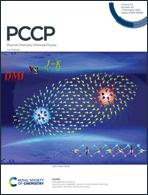 |
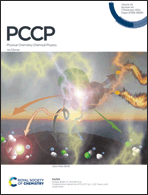 |
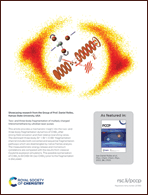 |
|
| Spontaneous magnetic merons in a half-metallic Mn2I3Br3 monolayer with easy-plane anisotropy
Zhong Shen, Yufei Xue, Zebin Wu and Changsheng Song Phys. Chem. Chem. Phys., 2022, 24, 27612 DOI:10.1039/D2CP03534K |
Fragmentation dynamics of CH3Clq+ (q = 2,3): theory and experiment
Pragya Bhatt, K. R. Maiyelvaganan, M. Prakash, J. Palaudoux, C. P. Safvan and M. Hochlaf Phys. Chem. Chem. Phys., 2022, 24, 27619 DOI:10.1039/D2CP02194C |
Two- and three-body fragmentation of multiply charged tribromomethane by ultrafast laser pulses
Surjendu Bhattacharyya, Kurtis Borne, Farzaneh Ziaee, Shashank Pathak, Enliang Wang, Anbu Selvam Venkatachalam, Nathan Marshall, Kevin D. Carnes, Charles W. Fehrenbach, Travis Severt, Itzik Ben-Itzhak, Artem Rudenko and Daniel Rolles Phys. Chem. Chem. Phys., 2022, 24, 27631 DOI:10.1039/D2CP03089F |
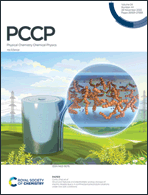 |
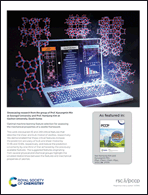 |
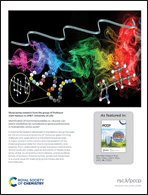 |
|
| Structural features and electrostatic energy storage of electric double layers in confined polyelectrolyte solutions under low-salt conditions
Kai Jiao, Wenyao Zhang, Rui Chuan, Huilong Yan, Anqi Zou, Qiuwang Wang, Chun Yang and Cunlu Zhao Phys. Chem. Chem. Phys., 2022, 24, 27009 DOI:10.1039/D2CP03576F |
Optimal machine learning feature selection for assessing the mechanical properties of a zeolite framework
Namjung Kim and Kyoungmin Min Phys. Chem. Chem. Phys., 2022, 24, 27031 DOI:10.1039/D2CP02949A |
Identification of incommensurability in L-leucine: can lattice instabilities be considered as general phenomena in hydrophobic amino acids?
Yannick Guinet, Laurent Paccou, Florence Danède, Patrick Derollez and Alain Hédoux Phys. Chem. Chem. Phys., 2022, 24, 27023 DOI:10.1039/D2CP00989G |
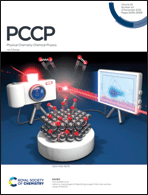 |
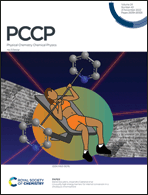 |
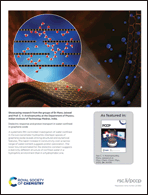 |
|
| Velocity map images of desorbing oxygen from sub-surface states of Rh(111)
Arved C. Dorst, Friedrich Güthoff, Daniel Schauermann, Alec M. Wodtke, Daniel R. Killelea and Tim Schäfer Phys. Chem. Chem. Phys., 2022, 24, 26421 DOI:10.1039/D2CP03369K |
Unusually high energy barriers for internal conversion in a {Ru(bpy)} chromophore
Agustina Cotic, Koen Veys, Daniel Escudero and Alejandro Cadranel Phys. Chem. Chem. Phys., 2022, 24, 26428 DOI:10.1039/D2CP03160D |
Dielectric response and proton transport in water confined in graphene oxide
Vikas Yadav, Anjan Das, C. V. Krishnamurthy and Manu Jaiswal Phys. Chem. Chem. Phys., 2022, 24, 26438 DOI:10.1039/D2CP03095K |
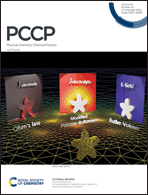 |
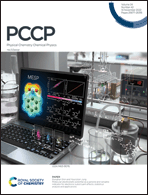 |
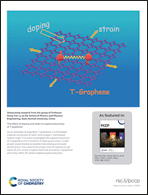 |
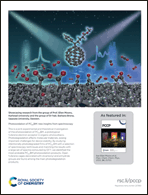 |
| Simulating electric field and current density in nanostructured electrocatalysts
Feng Li, Ce Zhou and Anna Klinkova Phys. Chem. Chem. Phys., 2022, 24, 25695 DOI:10.1039/D2CP02846H |
Molecular electrostatic potential as a general and versatile indicator for electronic substituent effects: statistical analysis and applications
Donghan Shin and YounJoon Jung Phys. Chem. Chem. Phys., 2022, 24, 25740 DOI:10.1039/D2CP03244A |
The effect of doping and strain on superconductivity of T-graphene
Shu-Xiang Qiao, Chang-Hao Sui, Liu Yang, Ya-Ping Li, Yu-Xin Sun, Nai-Xin Zhang, Jia-Qi Bai, Na Jiao and Hong-Yan Lu Phys. Chem. Chem. Phys., 2022, 24, 25767 DOI:10.1039/D2CP03155H |
Photooxidation of PC60BM: new insights from spectroscopy
Iulia Emilia Brumboiu, Leif K.E. Ericsson, Vanja Blazinic, Rickard Hansson, Andreas Opitz, Barbara Brena and Ellen Moons Phys. Chem. Chem. Phys., 2022, 24, 25753 DOI:10.1039/D2CP03514F |
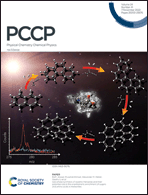 |
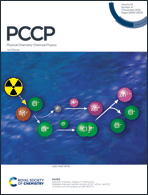 |
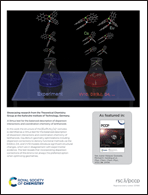 |
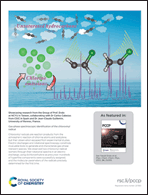 |
| Gas-phase synthesis of racemic helicenes and their potential role in the enantiomeric enrichment of sugars and amino acids in meteorites
Ralf I. Kaiser, Long Zhao, Wenchao Lu, Musahid Ahmed, Mikhail M. Evseev, Valeriy N. Azyazov, Alexander M. Mebel, Rana K. Mohamed, Felix R. Fischer and Xiaohu Li Phys. Chem. Chem. Phys., 2022, 24, 25077 DOI:10.1039/D2CP03084E |
Radiation-induced reaction kinetics of Zn2+ with eS− and Cl2˙− in Molten LiCl–KCl eutectic at 400–600 °C
Kazuhiro Iwamatsu, Gregory P. Horne, Ruchi Gakhar, Phillip Halstenberg, Bobby Layne, Simon M. Pimblott and James F. Wishart Phys. Chem. Chem. Phys., 2022, 24, 25088 DOI:10.1039/D2CP01194H |
A litmus test for the balanced description of dispersion interactions and coordination chemistry of lanthanoids
Juana Vázquez Quesada, Jiří Chmela, Jean-François Greisch, Wim Klopper and Michael E. Harding Phys. Chem. Chem. Phys., 2022, 24, 25106 DOI:10.1039/D2CP01414A |
Gas-phase spectroscopic identification of the chlorovinyl radical
Carlos Cabezas, Ching-Hua Chang, Jean-Claude Guillemin and Yasuki Endo Phys. Chem. Chem. Phys., 2022, 24, 25099 DOI:10.1039/D2CP03578B |
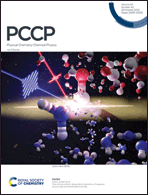 |
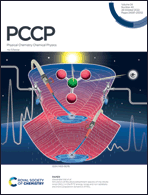 |
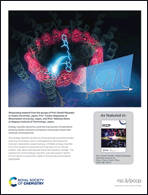 |
|
| The primary photo-dissociation dynamics of aqueous formamide and dimethylformamide
Jan Thøgersen, Tobias Weidner and Frank Jensen Phys. Chem. Chem. Phys., 2022, 24, 24695 DOI:10.1039/D2CP03166C |
Simulation of the photodetachment spectra of the nitrate anion (NO3−) in the 2E′ energy range and non-adiabatic electronic population dynamics of NO3
David M. G. Williams, Wolfgang Eisfeld and Alexandra Viel Phys. Chem. Chem. Phys., 2022, 24, 24706 DOI:10.1039/D2CP02873E |
Energy transfer dynamics and the mechanism of biohybrid photosynthetic antenna complexes chemically linked with artificial chromophores
Yusuke Yoneda, Tomoyasu Noji, Naoto Mizutani, Daiji Kato, Masaharu Kondo, Hiroshi Miyasaka, Yutaka Nagasawa and Takehisa Dewa Phys. Chem. Chem. Phys., 2022, 24, 24714 DOI:10.1039/D2CP02465A |
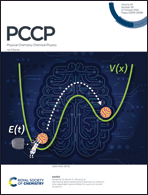 |
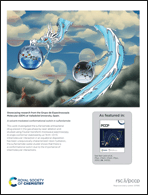 |
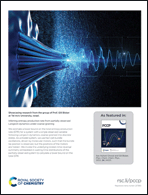 |
|
| Harnessing deep reinforcement learning to construct time-dependent optimal fields for quantum control dynamics
Yuanqi Gao, Xian Wang, Nanpeng Yu and Bryan M. Wong Phys. Chem. Chem. Phys., 2022, 24, 24012 DOI:10.1039/D2CP02495K |
A solvent-mediated conformational switch in sulfanilamide
Sergio Mato, Raúl Aguado, Santiago Mata, José Luis Alonso and Iker León Phys. Chem. Chem. Phys., 2022, 24, 24032 DOI:10.1039/D2CP03367D |
Inferring entropy production rate from partially observed Langevin dynamics under coarse-graining
Aishani Ghosal and Gili Bisker Phys. Chem. Chem. Phys., 2022, 24, 24021 DOI:10.1039/D2CP03064K |
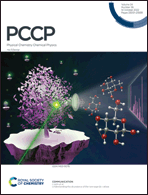 |
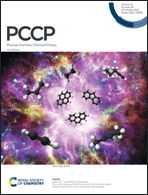 |
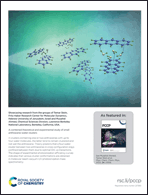 |
|
| Understanding the abundance of the rare sugar β-D-allose
G. Juárez, E. R. Alonso, M. Sanz-Novo, J. L. Alonso and I. León Phys. Chem. Chem. Phys., 2022, 24, 23076 DOI:10.1039/D2CP03213A |
The kinetic energy of PAH dication and trication dissociation determined by recoil-frame covariance map imaging
Jason W. L. Lee, Denis S. Tikhonov, Felix Allum, Rebecca Boll, Pragya Chopra, Benjamin Erk, Sebastian Gruet, Lanhai He, David Heathcote, Mehdi M. Kazemi, Jan Lahl, Alexander K. Lemmens, Donatella Loru, Sylvain Maclot, Robert Mason, Erland Müller, Terry Mullins, Christopher Passow, Jasper Peschel, Daniel Ramm, Amanda L. Steber, Sadia Bari, Mark Brouard, Michael Burt, Jochen Küpper, Per Eng-Johnsson, Anouk M. Rijs, Daniel Rolles, Claire Vallance, Bastian Manschwetus and Melanie Schnell Phys. Chem. Chem. Phys., 2022, 24, 23096 DOI:10.1039/D2CP02252D |
A combined theoretical and experimental study of small anthracene–water clusters
Estefania Rossich Molina, Bo Xu, Oleg Kostko, Musahid Ahmed and Tamar Stein Phys. Chem. Chem. Phys., 2022, 24, 23106 DOI:10.1039/D2CP02617A |
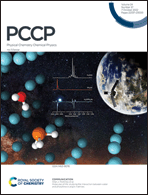 |
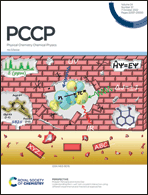 |
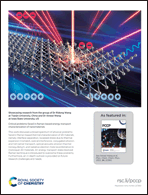 |
|
| Molecules of life: studying the interaction between water and phosphine in argon matrices
Matthew H. V. Graneri, Duncan A. Wild and Allan J. McKinley Phys. Chem. Chem. Phys., 2022, 24, 22426 DOI:10.1039/D2CP03434D |
Understanding the n → π* non-covalent interaction using different experimental and theoretical approaches
Prakash Panwaria and Aloke Das Phys. Chem. Chem. Phys., 2022, 24, 22371 DOI:10.1039/D2CP02070J |
Critical problems faced in Raman-based energy transport characterization of nanomaterials
Ridong Wang, Nicholas Hunter, Hamidreza Zobeiri, Shen Xu and Xinwei Wang Phys. Chem. Chem. Phys., 2022, 24, 22390 DOI:10.1039/D2CP02126A |
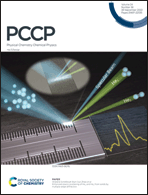 |
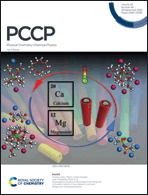 |
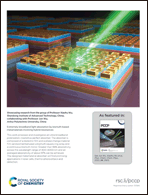 |
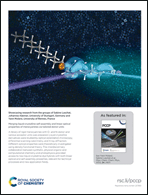 |
| Enhanced elastic scattering of He2 and He3 from solids by multiple-edge diffraction
Lee Yeong Kim, Sanghwan Park, Chang Young Lee, Wieland Schöllkopf and Bum Suk Zhao Phys. Chem. Chem. Phys., 2022, 24, 21593 DOI:10.1039/D2CP02641D |
Investigating the abnormal conductivity behaviour of divalent cations in low dielectric constant tetraglyme-based electrolytes
Long Hoang Bao Nguyen, Tanguy Picard, Cristina Iojoiu, Fannie Alloin, Nicolas Sergent, Marie-Liesse Doublet and Jean-Sébastien Filhol Phys. Chem. Chem. Phys., 2022, 24, 21601 DOI:10.1039/D2CP03200G |
Extremely broadband light absorption by bismuth-based metamaterials involving hybrid resonances
Jun Wu, Dengchao Huang, Biyuan Wu and Xiaohu Wu Phys. Chem. Chem. Phys., 2022, 24, 21612 DOI:10.1039/D2CP02869G |
Merging liquid crystalline self-assembly and linear optical properties of merocyanines via tailored donor units
Philipp Ehni, Soeren M. Bauch, Patrick M. Becker, Wolfgang Frey, Anna Zens, Johannes Kästner, Yann Molard and Sabine Laschat Phys. Chem. Chem. Phys., 2022, 24, 21617 DOI:10.1039/D2CP02237K |
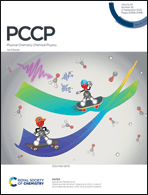 |
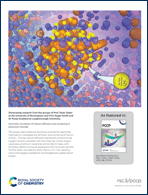 |
||
| Stable excited dication: trapping on the S1 state of formaldehyde dication after strong field ionization
Vaibhav Singh, Chuan Cheng, Thomas Weinacht and Spiridoula Matsika Phys. Chem. Chem. Phys., 2022, 24, 20701 DOI:10.1039/D2CP02604J |
Atomistic simulation of helium diffusion and clustering in plutonium dioxide
Elanor Murray, Ying Zhou, Peter Slater, Roger Smith, Pooja Goddard and Helen Steele Phys. Chem. Chem. Phys., 2022, 24, 20709 DOI:10.1039/D2CP02244C |
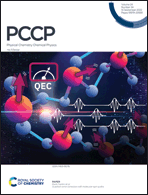 |
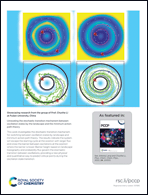 |
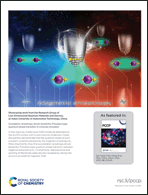 |
|
| Quantum error correction with molecular spin qudits
Mario Chizzini, Luca Crippa, Luca Zaccardi, Emilio Macaluso, Stefano Carretta, Alessandro Chiesa and Paolo Santini Phys. Chem. Chem. Phys., 2022, 24, 20030 DOI:10.1039/D2CP01228F |
Unraveling the stochastic transition mechanism between oscillation states by the landscape and the minimum action path theory
Jintong Lang and Chunhe Li Phys. Chem. Chem. Phys., 2022, 24, 20050 DOI:10.1039/D2CP01385A |
Correlation anisotropy driven Kosterlitz–Thouless-type quantum phase transition in a Kondo simulator
Wang-Huai Zhou, Jun Zhang, Nan Nan, Wei Li, Ze-Dong He, Zhan-Wu Zhu, Yun-Pei Wu and Yong-Chen Xiong Phys. Chem. Chem. Phys., 2022, 24, 20040 DOI:10.1039/D2CP01668K |
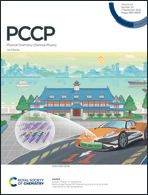 |
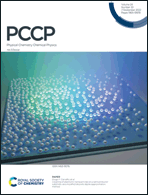 |
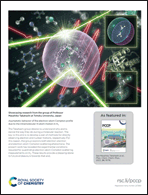 |
|
| Black phosphorene/NP heterostructure as a novel anode material for Li/Na-ion batteries
Yanwei Wang, Wu Tian, Huijuan Zhang and Yu Wang Phys. Chem. Chem. Phys., 2022, 24, 19697 DOI:10.1039/D2CP02922G |
Coupling of plasmonic nanoparticles on a semiconductor substrate via a modified discrete dipole approximation method
Diogo F. Carvalho, Manuel A. Martins, Paulo A. Fernandes and M. Rosário P. Correia Phys. Chem. Chem. Phys., 2022, 24, 19705 DOI:10.1039/D2CP02446B |
Asymptotic behavior of the electron-atom Compton profile due to the intramolecular H-atom motion in H2
Yuuki Onitsuka, Yuichi Tachibana and Masahiko Takahashi Phys. Chem. Chem. Phys., 2022, 24, 19716 DOI:10.1039/D2CP02461F |
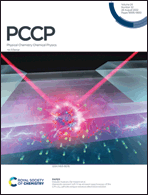 |
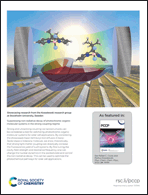 |
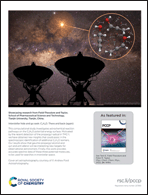 |
|
| Operando resonant soft X-ray emission spectroscopy of the LiMn2O4 cathode using an aqueous electrolyte solution
Daisuke Asakura, Yusuke Nanba, Hideharu Niwa, Hisao Kiuchi, Jun Miyawaki, Masashi Okubo, Hirofumi Matsuda, Yoshihisa Harada and Eiji Hosono Phys. Chem. Chem. Phys., 2022, 24, 19177 DOI:10.1039/D2CP01040B |
Suppressing non-radiative decay of photochromic organic molecular systems in the strong coupling regime
Rafael C. Couto and Markus Kowalewski Phys. Chem. Chem. Phys., 2022, 24, 19199 DOI:10.1039/D2CP00774F |
Interstellar hide and go seek: C3H4O. There and back (again)
Terri E. Field-Theodore and Peter R. Taylor Phys. Chem. Chem. Phys., 2022, 24, 19184 DOI:10.1039/D2CP00995A |
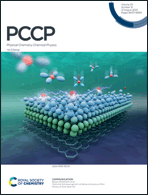 |
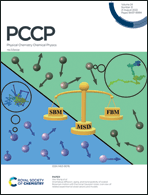 |
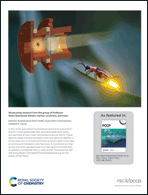 |
|
| Transition between growth of dense and porous films: theory of dual-layer SEI
Lars von Kolzenberg, Martin Werres, Jonas Tetzloff and Birger Horstmann Phys. Chem. Chem. Phys., 2022, 24, 18469 DOI:10.1039/D2CP00188H |
Anomalous diffusion, aging, and nonergodicity of scaled Brownian motion with fractional Gaussian noise: overview of related experimental observations and models
Wei Wang, Ralf Metzler and Andrey G. Cherstvy Phys. Chem. Chem. Phys., 2022, 24, 18482 DOI:10.1039/D2CP01741E |
Intrinsic fluorescence from firefly oxyluciferin monoanions isolated in vacuo
Christina Kjær, Jeppe Langeland and Steen Brøndsted Nielsen Phys. Chem. Chem. Phys., 2022, 24, 18505 DOI:10.1039/D2CP02024F |
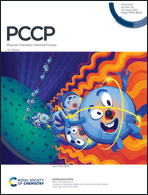 |
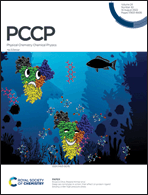 |
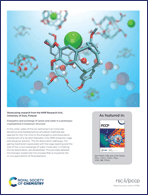 |
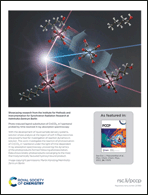 |
| Variation of bending rigidity with material density: bilayer silica with nanoscale holes
Martin Tømterud, Sabrina D. Eder, Christin Büchner, Markus Heyde, Hans-Joachim Freund, Joseph R. Manson and Bodil Holst Phys. Chem. Chem. Phys., 2022, 24, 17941 DOI:10.1039/D2CP01960D |
Deep sea osmolytes in action: their effect on protein–ligand binding under high pressure stress
Armin Kamali, Nisrine Jahmidi-Azizi, Rosario Oliva and Roland Winter Phys. Chem. Chem. Phys., 2022, 24, 17966 DOI:10.1039/D2CP01769E |
Energetics and exchange of xenon and water in a prototypic cryptophane-A biosensor structure
Perttu Hilla and Juha Vaara Phys. Chem. Chem. Phys., 2022, 24, 17946 DOI:10.1039/D2CP01889F |
Photo-induced ligand substitution of Cr(CO)6 in 1-pentanol probed by time resolved X-ray absorption spectroscopy
Eric J. Mascarenhas, Mattis Fondell, Robby Büchner, Sebastian Eckert, Vinícius Vaz da Cruz and Alexander Föhlisch Phys. Chem. Chem. Phys., 2022, 24, 17979 DOI:10.1039/D1CP05834G |
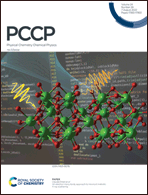 |
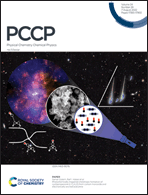 |
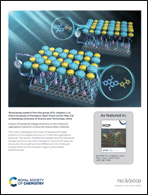 |
|
| All-electron many-body approach to resonant inelastic X-ray scattering
Christian Vorwerk, Francesco Sottile and Claudia Draxl Phys. Chem. Chem. Phys., 2022, 24, 17439 DOI:10.1039/D2CP00994C |
Photochemically triggered cheletropic formation of cyclopropenone (c-C3H2O) from carbon monoxide and electronically excited acetylene
Jia Wang, N. Fabian Kleimeier, Rebecca N. Johnson, Samer Gozem, Matthew J. Abplanalp, Andrew M. Turner, Joshua H. Marks and Ralf I. Kaiser Phys. Chem. Chem. Phys., 2022, 24, 17449 DOI:10.1039/D2CP01978G |
Impact of backbone linkage positions on the molecular aggregation behavior of polymer photovoltaic materials
Jinyue Zhu, Yanfang Liu, Shaohua Huang, Shuguang Wen, Xichang Bao, Mian Cai and Jingwen Li Phys. Chem. Chem. Phys., 2022, 24, 17462 DOI:10.1039/D2CP01060G |
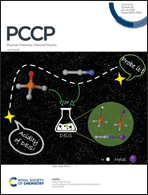 |
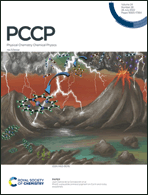 |
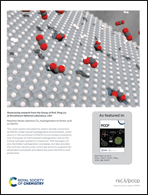 |
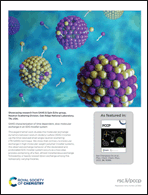 |
| Acidity scales of deep eutectic solvents based on IR and NMR
Fengyi Zhou, Ruifen Shi, Yingxiong Wang, Zhimin Xue, Baolong Zhang and Tiancheng Mu Phys. Chem. Chem. Phys., 2022, 24, 16973 DOI:10.1039/D2CP01816K |
Phot0, a plausible primeval pigment on Earth and rocky exoplanets
Juan García de la Concepción, Luis Cerdán, Pablo Marcos-Arenal, Mercedes Burillo-Villalobos, Nuria Fonseca-Bonilla, Rubén Lizcano-Vaquero, María-Ángeles López-Cayuela, José A. Caballero and Felipe Gómez Phys. Chem. Chem. Phys., 2022, 24, 16979 DOI:10.1039/D2CP01703B |
Reaction-driven selective CO2 hydrogenation to formic acid on Pd(111)
Hong Zhang, Xuelong Wang and Ping Liu Phys. Chem. Chem. Phys., 2022, 24, 16997 DOI:10.1039/D2CP01971J |
SANS characterization of time dependent, slow molecular exchange in an SDS micellar system
Tooba Shoaib, Jae-Min Ha, Youngkyu Han, Wei-Ren Chen and Changwoo Do Phys. Chem. Chem. Phys., 2022, 24, 16988 DOI:10.1039/D2CP00930G |
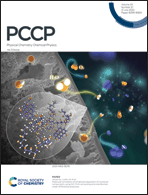 |
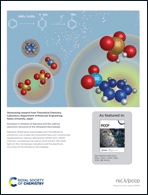 |
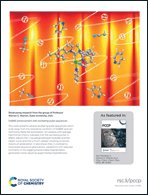 |
|
| Molecular simulation of enhanced separation of humid air components using GO–PVA nanocomposite membranes under differential pressures
Yilin Liu, Jincai Su, Fei Duan, Xin Cui, Weichao Yan and Liwen Jin Phys. Chem. Chem. Phys., 2022, 24, 16442 DOI:10.1039/D2CP01411D |
Solvation in nitration of benzene and the valence electronic structure of the Wheland intermediate
Kaho Nakatani, Sho Teshigawara, Yuta Tanahashi, Kento Kasahara, Masahiro Higashi and Hirofumi Sato Phys. Chem. Chem. Phys., 2022, 24, 16453 DOI:10.1039/D2CP01699K |
SABRE enhancement with oscillating pulse sequences
Xiaoqing Li, Jacob R. Lindale, Shannon L. Eriksson and Warren S. Warren Phys. Chem. Chem. Phys., 2022, 24, 16462 DOI:10.1039/D2CP00899H |
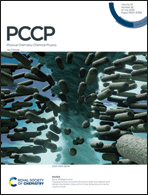 |
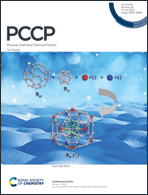 |
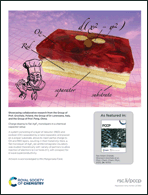 |
|
| Topological fine structure of smectic grain boundaries and tetratic disclination lines within three-dimensional smectic liquid crystals
Paul A. Monderkamp, René Wittmann, Michael te Vrugt, Axel Voigt, Raphael Wittkowski and Hartmut Löwen Phys. Chem. Chem. Phys., 2022, 24, 15691 DOI:10.1039/D2CP00060A |
B96: a complete core–shell structure with high symmetry
Linwei Sai, Xue Wu and Fengyu Li Phys. Chem. Chem. Phys., 2022, 24, 15687 DOI:10.1039/D2CP01865A |
Charge doping to flat AgF2 monolayers in a chemical capacitor setup
Daniel Jezierski, Adam Grzelak, Xiaoqiang Liu, Shishir Kumar Pandey, Maria N. Gastiasoro, José Lorenzana, Ji Feng and Wojciech Grochala Phys. Chem. Chem. Phys., 2022, 24, 15705 DOI:10.1039/D2CP00179A |
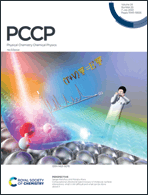 |
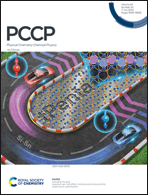 |
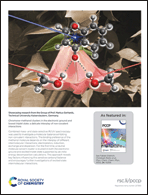 |
|
| Computational vibrational spectroscopy of molecule–surface interactions: what is still difficult and what can be done about it
Sergei Manzhos and Manabu Ihara Phys. Chem. Chem. Phys., 2022, 24, 15158 DOI:10.1039/D2CP01389D |
Quantum spin Hall effect in tilted penta silicene and its isoelectronic substitutions
Lijin Zhan, Yimei Fang, Ruotong Zhang, Xiancong Lu, Tie-yu Lü, Xinrui Cao, Zizhong Zhu and Shunqing Wu Phys. Chem. Chem. Phys., 2022, 24, 15201 DOI:10.1039/D2CP01390H |
Chromone–methanol clusters in the electronic ground and lowest triplet state: a delicate interplay of non-covalent interactions
Pol Boden, Patrick H. Strebert, Marcel Meta, Fabian Dietrich, Christoph Riehn and Markus Gerhards Phys. Chem. Chem. Phys., 2022, 24, 15208 DOI:10.1039/D2CP01341J |
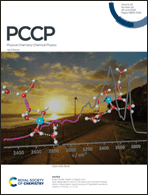 |
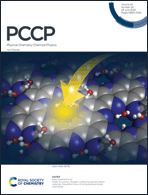 |
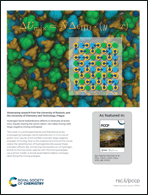 |
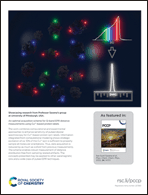 |
| Size-dependent H and H2 formation by infrared multiple photon dissociation spectroscopy of hydrated vanadium cations, V+(H2O)n, n = 3–51
Jakob Heller, Ethan M. Cunningham, Jessica C. Hartmann, Christian van der Linde, Milan Ončák and Martin K. Beyer Phys. Chem. Chem. Phys., 2022, 24, 14699 DOI:10.1039/D2CP00833E |
Water on porous, nitrogen-containing layered carbon materials: the performance of computational model chemistries
Christopher Penschke, Robert Edler von Zander, Alkit Beqiraj, Anna Zehle, Nicolas Jahn, Rainer Neumann and Peter Saalfrank Phys. Chem. Chem. Phys., 2022, 24, 14709 DOI:10.1039/D2CP00657J |
Hydrogen bond redistribution effects in mixtures of protic ionic liquids sharing the same cation: non-ideal mixing with large negative mixing enthalpies
Benjamin Golub, Daniel Ondo, Viviane Overbeck, Ralf Ludwig and Dietmar Paschek Phys. Chem. Chem. Phys., 2022, 24, 14740 DOI:10.1039/D2CP01209J |
An optimal acquisition scheme for Q-band EPR distance measurements using Cu2+-based protein labels
Xiaowei Bogetti, Zikri Hasanbasri, Hannah R. Hunter and Sunil Saxena Phys. Chem. Chem. Phys., 2022, 24, 14727 DOI:10.1039/D2CP01032A |
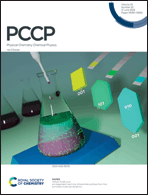 |
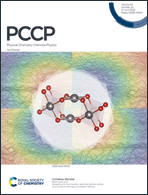 |
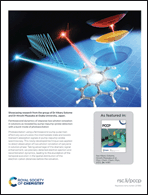 |
|
| pH dependent reactivity of boehmite surfaces from first principles molecular dynamics
William Smith, Maxime Pouvreau, Kevin Rosso and Aurora E. Clark Phys. Chem. Chem. Phys., 2022, 24, 14177 DOI:10.1039/D2CP00534D |
Designing 3d metal oxides: selecting optimal density functionals for strongly correlated materials
Ina Østrøm, Md. Anower Hossain, Patrick A. Burr, Judy N. Hart and Bram Hoex Phys. Chem. Chem. Phys., 2022, 24, 14119 DOI:10.1039/D2CP01303G |
Femtosecond dynamics of stepwise two-photon ionization in solutions as revealed by pump–repump–probe detection with a burst mode of photoexcitation
Hikaru Sotome, Masafumi Koga, Tomoya Sawada and Hiroshi Miyasaka Phys. Chem. Chem. Phys., 2022, 24, 14187 DOI:10.1039/D1CP03866D |
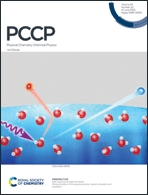 |
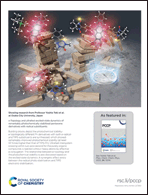 |
||
| Photoionization of the aqueous phase: clusters, droplets and liquid jets
Ruth Signorell and Bernd Winter Phys. Chem. Chem. Phys., 2022, 24, 13438 DOI:10.1039/D2CP00164K |
π-Topology and ultrafast excited-state dynamics of remarkably photochemically stabilized pentacene derivatives with radical substituents
Nishiki Minami, Kohei Yoshida, Keijiro Maeguchi, Ken Kato, Akihiro Shimizu, Genta Kashima, Masazumi Fujiwara, Chiasa Uragami, Hideki Hashimoto and Yoshio Teki Phys. Chem. Chem. Phys., 2022, 24, 13514 DOI:10.1039/D2CP00683A |
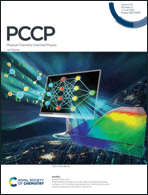 |
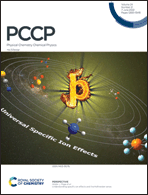 |
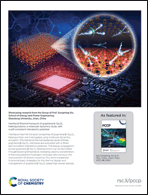 |
|
| Representing globally accurate reactive potential energy surfaces with complex topography by combining Gaussian process regression and neural networks
Zijiang Yang, Hanghang Chen and Maodu Chen Phys. Chem. Chem. Phys., 2022, 24, 12827 DOI:10.1039/D2CP00719C |
Understanding specific ion effects and the Hofmeister series
Kasimir P. Gregory, Gareth R. Elliott, Hayden Robertson, Anand Kumar, Erica J. Wanless, Grant B. Webber, Vincent S. J. Craig, Gunther G. Andersson and Alister J. Page Phys. Chem. Chem. Phys., 2022, 24, 12682 DOI:10.1039/D2CP00847E |
Interfacial thermal transport of graphene/β-Ga2O3 heterojunctions: a molecular dynamics study with a self-consistent interatomic potential
Shilin Dong, Bowen Yang, Qian Xin, Xin Lan, Xinyu Wang and Gongming Xin Phys. Chem. Chem. Phys., 2022, 24, 12837 DOI:10.1039/D1CP05749A |
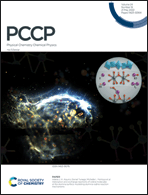 |
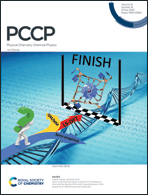 |
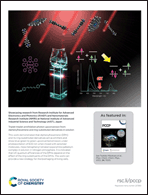 |
|
| Adsorption and exchange reactions of iodine molecules at the alumina surface: modelling alumina-iodine reaction mechanisms
Kelsea K. Miller, Armando de Rezende, Adelia J. A. Aquino, Daniel Tunega and Michelle L. Pantoya Phys. Chem. Chem. Phys., 2022, 24, 11501 DOI:10.1039/D1CP05924F |
Semi-empirical and linear-scaling DFT methods to characterize duplex DNA and G-quadruplexes in the presence of interacting small molecules
Iker Ortiz de Luzuriaga, Sawssen Elleuchi, Khaled Jarraya, Emilio Artacho, Xabier López and Adrià Gil Phys. Chem. Chem. Phys., 2022, 24, 11510 DOI:10.1039/D2CP00214K |
Triplet–triplet annihilation photon upconversion from diphenylhexatriene and ring-substituted derivatives in solution
Toshiko Mizokuro, Kenji Kamada and Yoriko Sonoda Phys. Chem. Chem. Phys., 2022, 24, 11520 DOI:10.1039/D1CP04784A |
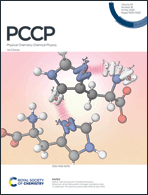 |
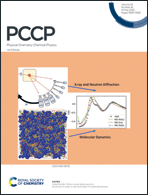 |
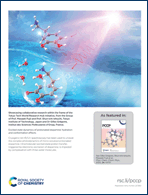 |
|
| Detection of remote proton–nitrogen correlations by 1H-detected 14N overtone solid-state NMR at fast MAS
Nghia Tuan Duong and Yusuke Nishiyama Phys. Chem. Chem. Phys., 2022, 24, 10717 DOI:10.1039/D2CP00155A |
Structure of water-in-salt and water-in-bisalt electrolytes
Miguel Angel González, Hiroshi Akiba, Oleg Borodin, Gabriel Julio Cuello, Louis Hennet, Shinji Kohara, Edward J. Maginn, Lucile Mangin-Thro, Osamu Yamamuro, Yong Zhang, David L. Price and Marie-Louise Saboungi Phys. Chem. Chem. Phys., 2022, 24, 10727 DOI:10.1039/D2CP00537A |
Excited state dynamics of protonated dopamine: hydration and conformation effects
Keisuke Hirata, Ken-Ichi Kasai, Koki Yoshizawa, Gilles Grégoire, Shun-Ichi Ishiuchi and Masaaki Fujii Phys. Chem. Chem. Phys., 2022, 24, 10737 DOI:10.1039/D2CP00543C |
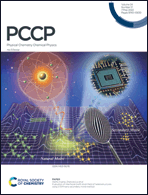 |
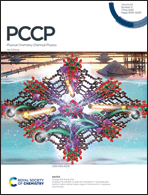 |
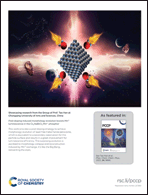 |
|
| Evaluation of interfacial misfit strain field of heterostructures using STEM nano secondary moiré method
Yao Zhao, Yang Yang, Huihui Wen, Chao Liu, Xianfu Huang and Zhanwei Liu Phys. Chem. Chem. Phys., 2022, 24, 9848 DOI:10.1039/D1CP05891F |
Probing the electronic and ionic transport in topologically distinct redox-active metal–organic frameworks in aqueous electrolytes
Cheng-Hui Shen, Yu-Hsiu Chen, Yi-Ching Wang, Tzu-En Chang, You-Liang Chen and Chung-Wei Kung Phys. Chem. Chem. Phys., 2022, 24, 9855 DOI:10.1039/D2CP00117A |
Post-doping induced morphology evolution boosts Mn2+ luminescence in the Cs2NaBiCl6:Mn2+ phosphor
Shuangqiang Fang, Ting Wang, Shuangshuang He, Tao Han, Mingsheng Cai, Bitao Liu, Vladimir I. Korepanov and Tianchun Lang Phys. Chem. Chem. Phys., 2022, 24, 9866 DOI:10.1039/D1CP05903C |
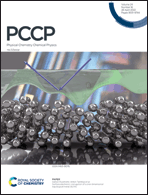 |
|||
| Surface electronic corrugation of a one-dimensional topological metal: Bi(114)
Stephan J. Schmutzler, Adrian Ruckhofer, Wolfgang E. Ernst and Anton Tamtögl Phys. Chem. Chem. Phys., 2022, 24, 9146 DOI:10.1039/D1CP05284E |
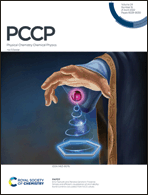 |
|||
| Simple and efficient visualization of aromaticity: bond currents calculated from NICS values
Eno Paenurk and Renana Gershoni-Poranne Phys. Chem. Chem. Phys., 2022, 24, 8631 DOI:10.1039/D1CP05757J |
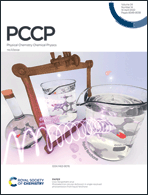 |
|||
| Photoelectron circular dichroism in angle-resolved photoemission from liquid fenchone
Marvin N. Pohl, Sebastian Malerz, Florian Trinter, Chin Lee, Claudia Kolbeck, Iain Wilkinson, Stephan Thürmer, Daniel M. Neumark, Laurent Nahon, Ivan Powis, Gerard Meijer, Bernd Winter and Uwe Hergenhahn Phys. Chem. Chem. Phys., 2022, 24, 8081 DOI:10.1039/D1CP05748K |
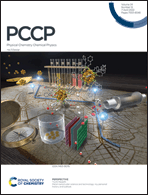 |
|||
| Metal-nanocluster science and technology: my personal history and outlook
Yuichi Negishi Phys. Chem. Chem. Phys., 2022, 24, 7569 DOI:10.1039/D1CP05689A |
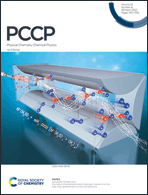 |
|||
| Formation of protonated water–hydrogen clusters in an ion trap mass spectrometer at room temperature
Dongbo Mi, Junqiang Xu, Yunpeng Zhang, Tenggao Zhu, Jiewen Ouyang, Xiaofeng Dong and Konstantin Chingin Phys. Chem. Chem. Phys., 2022, 24, 7180 DOI:10.1039/D1CP04516D |
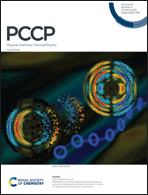 |
|||
| Photoelectron elliptical dichroism spectroscopy of resonance-enhanced multiphoton ionization via the 3s, 3p and 3d Rydberg series in fenchone
Sandra Beauvarlet, Etienne Bloch, Debobrata Rajak, Dominique Descamps, Baptiste Fabre, Stéphane Petit, Bernard Pons, Yann Mairesse and Valérie Blanchet Phys. Chem. Chem. Phys., 2022, 24, 6415 DOI:10.1039/D1CP05618B |
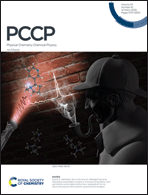 |
|||
| Gas phase protonated nicotine is a mixture of pyridine- and pyrrolidine-protonated conformers: implications for its native structure in the nicotinic acetylcholine receptor
Naoya Takeda, Keisuke Hirata, Kazuya Tsuruta, Garrett D. Santis, Sotiris S. Xantheas, Shun-ichi Ishiuchi and Masaaki Fujii Phys. Chem. Chem. Phys., 2022, 24, 5786 DOI:10.1039/D1CP05175J |
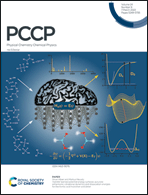 |
|||
| Transfer learned potential energy surfaces: accurate anharmonic vibrational dynamics and dissociation energies for the formic acid monomer and dimer
Silvan Käser and Markus Meuwly Phys. Chem. Chem. Phys., 2022, 24, 5269 DOI:10.1039/D1CP04393E |
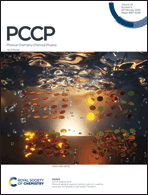 |
|||
| Physical aging in aqueous nematic gels of a swelling nanoclay: sol (phase) to gel (state) transition
Mohammad Shoaib, Nahid Molaei and Erin R. Bobicki Phys. Chem. Chem. Phys., 2022, 24, 4703 DOI:10.1039/D1CP03399A |
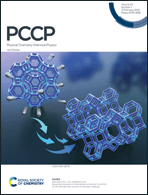 |
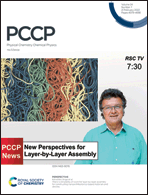 |
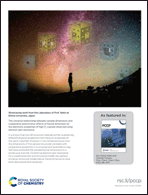 |
|
| Revealing scenarios of interzeolite conversion from FAU to AEI through the variation of starting materials
Zhendong Liu, Anand Chokkalingam, Shoko Miyagi, Masato Yoshioka, Tomoya Ishikawa, Hiroki Yamada, Koji Ohara, Nao Tsunoji, Yusuke Naraki, Tsuneji Sano, Tatsuya Okubo and Toru Wakihara Phys. Chem. Chem. Phys., 2022, 24, 4136 DOI:10.1039/D1CP03751J |
There is still plenty of room for layer-by-layer assembly for constructing nanoarchitectonics-based materials and devices
Katsuhiko Ariga, Yuri Lvov and Gero Decher Phys. Chem. Chem. Phys., 2022, 24, 4097 DOI:10.1039/D1CP04669A |
The universal relationship between sample dimensions and cooperative phenomena: effects of fractal dimension on the electronic properties of high-TC cuprate observed using electron spin resonance
Toshio Naito and Yoshiaki Fukuda Phys. Chem. Chem. Phys., 2022, 24, 4147 DOI:10.1039/D1CP04709D |
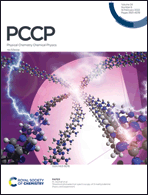 |
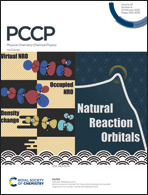 |
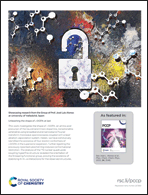 |
|
| Threshold photoelectron spectroscopy of 9-methyladenine: theory and experiment
K. Laamiri, G. A. Garcia, L. Nahon, A. Ben Houria, R. Feifel and M. Hochlaf Phys. Chem. Chem. Phys., 2022, 24, 3523 DOI:10.1039/D1CP03729C |
Natural reaction orbitals for characterizing electron transfer responsive to nuclear coordinate displacement
Shuichi Ebisawa, Masatoshi Hasebe, Takuro Tsutsumi, Takao Tsuneda and Tetsuya Taketsugu Phys. Chem. Chem. Phys., 2022, 24, 3532 DOI:10.1039/D1CP04491E |
Unleashing the shape of L-DOPA at last
Miguel Sanz-Novo, Iker León, Elena R. Alonso and José L. Alonso Phys. Chem. Chem. Phys., 2022, 24, 3546 DOI:10.1039/D1CP05066D |
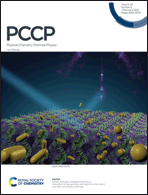 |
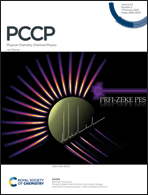 |
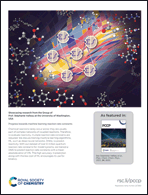 |
|
| Interaction of nanoparticles with lipid films: the role of symmetry and shape anisotropy
Lucrezia Caselli, Andrea Ridolfi, Gaetano Mangiapia, Pierfrancesco Maltoni, Jean-François Moulin, Debora Berti, Nina-Juliane Steinke, Emil Gustafsson, Tommy Nylander and Costanza Montis Phys. Chem. Chem. Phys., 2022, 24, 2762 DOI:10.1039/D1CP03201A |
Pulsed-ramped-field-ionization zero-kinetic-energy photoelectron spectroscopy: a methodological advance
Oliver J. Harper, Ning L. Chen, Séverine Boyé-Péronne and Bérenger Gans Phys. Chem. Chem. Phys., 2022, 24, 2777 DOI:10.1039/D1CP04569E |
Progress towards machine learning reaction rate constants
Evan Komp, Nida Janulaitis and Stéphanie Valleau Phys. Chem. Chem. Phys., 2022, 24, 2692 DOI:10.1039/D1CP04422B |
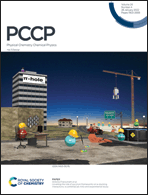 |
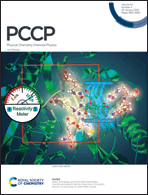 |
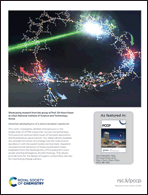 |
|
| Unveiling the role of pyrylium frameworks on π-stacking interactions: a combined ab initio and experimental study
Reyes Núñez-Franco, Gonzalo Jiménez-Osés, Jesús Jiménez-Barbero, Francisca Cabrera-Escribano and Antonio Franconetti Phys. Chem. Chem. Phys., 2022, 24, 1965 DOI:10.1039/D1CP02622D |
Can the local electric field be a descriptor of catalytic activity? A case study on chorismate mutase
Shakir Ali Siddiqui and Kshatresh Dutta Dubey Phys. Chem. Chem. Phys., 2022, 24, 1974 DOI:10.1039/D1CP03978D |
Intrachain photophysics of a donor–acceptor copolymer
Hak-Won Nho, Won-Woo Park, Byongkyu Lee, Seoyoung Kim, Changduk Yang and Oh-Hoon Kwon Phys. Chem. Chem. Phys., 2022, 24, 1982 DOI:10.1039/D1CP04093F |
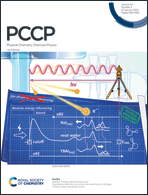 |
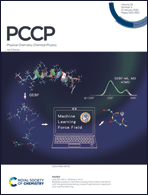 |
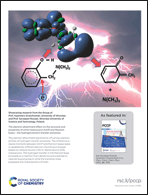 |
|
| Quantitative electronic structure and work-function changes of liquid water induced by solute
Bruno Credidio, Michele Pugini, Sebastian Malerz, Florian Trinter, Uwe Hergenhahn, Iain Wilkinson, Stephan Thürmer and Bernd Winter Phys. Chem. Chem. Phys., 2022, 24, 1310 DOI:10.1039/D1CP03165A |
Building quantum mechanics quality force fields of proteins with the generalized energy-based fragmentation approach and machine learning
Zheng Cheng, Jiahui Du, Lei Zhang, Jing Ma, Wei Li and Shuhua Li Phys. Chem. Chem. Phys., 2022, 24, 1326 DOI:10.1039/D1CP03934B |
The electron attachment effect on the structure and properties of ortho-hydroxyaryl Schiff and Mannich bases – the hydrogen/proton transfer processes
Jerzy J. Jański, Szczepan Roszak, Kazimierz Orzechowski and Lucjan Sobczyk Phys. Chem. Chem. Phys., 2022, 24, 1338 DOI:10.1039/D1CP03723D |
|
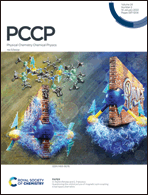 |
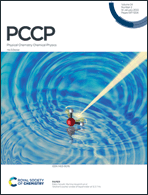 |
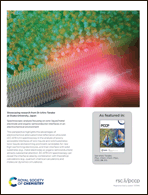 |
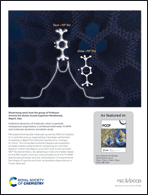 |
| Questioning the orbital picture of magnetic spin coupling: a real space alternative
A. Martín Pendás and E. Francisco Phys. Chem. Chem. Phys., 2022, 24, 639 DOI:10.1039/D1CP03485E |
Terahertz pump–probe of liquid water at 12.3 THz
Fabio Novelli, Claudius Hoberg, Ellen M. Adams, J. Michael Klopf and Martina Havenith Phys. Chem. Chem. Phys., 2022, 24, 653 DOI:10.1039/D1CP03207K |
Spectroscopic analysis focusing on ionic liquid/metal electrode and organic semiconductor interfaces in an electrochemical environment
Ichiro Tanabe Phys. Chem. Chem. Phys., 2022, 24, 615 DOI:10.1039/D1CP04094D |
Collective dynamics of molecular rotors in periodic mesoporous organosilica: a combined solid-state 2H-NMR and molecular dynamics simulation study
Antonio De Nicola, Andrea Correa, Silvia Bracco, Jacopo Perego, Piero Sozzani, Angiolina Comotti and Giuseppe Milano Phys. Chem. Chem. Phys., 2022, 24, 666 DOI:10.1039/D1CP05013C |
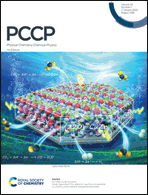 |
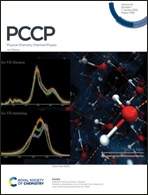 |
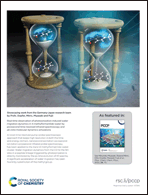 |
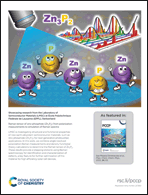 |
| Facet-dependent CO2 reduction reactions on kesterite Cu2ZnSnS4 photo-electro-integrated electrodes
Ruifen Zhang, Xin Wen, Hongliang Peng, Yongpeng Xia, Fen Xu and Lixian Sun Phys. Chem. Chem. Phys., 2022, 24, 48 DOI:10.1039/D1CP03595A |
Dielectric properties of ice VII under the influence of time-alternating external electric fields
Zdenek Futera and Niall J. English Phys. Chem. Chem. Phys., 2022, 24, 56 DOI:10.1039/D1CP04165G |
Real-time observation of photoionization-induced water migration dynamics in 4-methylformanilide–water by picosecond time-resolved infrared spectroscopy and ab initio molecular dynamics simulations
Mitsuhiko Miyazaki, Tairiku Kamiya, Matthias Wohlgemuth, Kuntal Chatterjee, Roland Mitrić, Otto Dopfer and Masaaki Fujii Phys. Chem. Chem. Phys., 2022, 24, 73 DOI:10.1039/D1CP03327A |
Raman tensor of zinc-phosphide (Zn3P2): from polarization measurements to simulation of Raman spectra
Mischa Flór, Elias Z. Stutz, Santhanu P. Ramanandan, Mahdi Zamani, Rajrupa Paul, Jean-Baptiste Leran, Alexander P. Litvinchuk, Anna Fontcuberta i Morral and Mirjana Dimitrievska Phys. Chem. Chem. Phys., 2022, 24, 63 DOI:10.1039/D1CP04322F |


